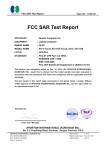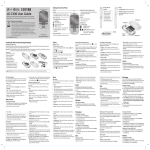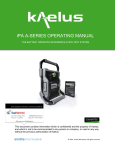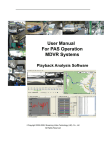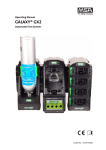Download Test Approach
Transcript
Specific Absorption Rate (SAR) Overview Presented by Mark Jenkins Wireless Business Manager, TÜV SÜD Product Service Vina Kerai Certification Supervisor, BABT TÜV SÜD Product Service GmbH Overview • Introduction to Specific Absorption Rate (SAR) – Why consider it? What is it? • Legislative considerations – Directives, test standards • Test Facilities – How do we measure SAR? – Various systems • Test requirements – Head and Body SAR testing – Simultaneous Transmission • Summary TÜV SÜD Product Service www.tuvps.co.uk www.babt.com 2006-05-10 2 Why consider SAR? TÜV SÜD Product Service www.tuvps.co.uk www.babt.com What is SAR? • SAR is the measure of how much energy (in this case Radio Frequency energy) is absorbed by the human body in a certain volume, over a certain period of time. (RF energy, per kilogram, per second) • A radio transmitter needs to make a link with a base station or other radio device in order to do what it is designed for. • Your body will absorb Radio energy and that will have a heating effect on your body the severity of which depends on various factors TÜV SÜD Product Service www.tuvps.co.uk www.babt.com What is SAR? - continued • Most SAR measurements are performed using calibrated E-field probes in conjunction with a Robotic arm (positional accuracy) and Data Acquisition Electronics (signal processing and detection) • SAR is expressed as a figure in W/kg Volume Averaged over 1g or 10g of body tissue. • The main formula for a spot SAR for E-field probes is:- E SAR 2 σ = Conductivity of the tissue (S/m) ρ = Mass density of the tissue (kg/m3) |E| = rms electric field strength (V/m) TÜV SÜD Product Service www.tuvps.co.uk www.babt.com What is SAR? - continued • The e-field standard SAR probe equation is directly proportional to the temperature change SAR equation. Temperature change measurements are rarely used for SAR readings mainly due to problems such as poor repeatability. • In practice complicated mathematical formula are applied to determine the ‗Volume Averaged‘ SAR figure. This is all dealt with by post processing software after each scan has been performed. • The probe is then positioned at various points within a ‗Phantom‘ filled with tissue simulant. • SAR Probes average out duty cycles of Radio devices that are not transmitting continuously. For example a GSM mobile only transmits for approximately 1/8 of the time so that a SAR probe measures 1/8th of the peak power from such devices. TÜV SÜD Product Service www.tuvps.co.uk www.babt.com Head, Body and Limb SAR • SAR tests: Head, Body & Limbs – Head – Mobile Phones, DECT phones etc. – Limbs: Ankle or wrist worn tracking devices – Body – Laptops containing RF modules, PDA‘s, Body-worn transmitters TÜV SÜD Product Service www.tuvps.co.uk www.babt.com RF Exposure • RF Exposure/MPE (Maximum Permissible Exposure) – Needs consideration if the human body could come into close proximity with an RF transmitter, but this is not the intention of the device, rather it is a consequence of it‘s use or positioning. E.g. Wireless router, Femto cell base station etc. – EN 62311 Generic Standard – EN 50385 General public Fixed terminals/Base Stations – EN 50371 Low Power (<20mW) (being superseded by EN 62479:2010) – Others… – For more information contact TÜV SÜD TÜV SÜD Product Service www.tuvps.co.uk www.babt.com Legislative considerations (R&TTE) • • For European Union: R&TTE Directive Conformance 1999/5/EC • Article 3.1(a) [Health and Safety of the user and bystanders] • Council Recommendation 1999/519/EC • Public exposure to electromagnetic fields • LVD Directive Conformance 2006/95/EC • RF Exposure: EN 62311: 2008 (This standard is intended to cover both intentional and non-intentional radiators.) TÜV SÜD Product Service www.tuvps.co.uk www.babt.com Legislative considerations (R&TTE Head SAR) • For European Union: OJ lists R&TTE EN 50360 Article 3.1(a) TÜV SÜD Product Service www.tuvps.co.uk www.babt.com Legislative considerations (R&TTE Head SAR) - Cont. TÜV SÜD Product Service www.tuvps.co.uk www.babt.com Legislative considerations (R&TTE Head SAR) - Cont. • Limits for European Union contained in Council Recommendation 1999/519/EC of 12th July 1999 Head SAR limit TÜV SÜD Product Service www.tuvps.co.uk www.babt.com Legislative considerations (R&TTE Head/Body SAR). • European standards for Head SAR – – EN 50360, EN 50360/AC 2006 – IEC/EN 62209-1, EN 50361 • European standards for Body SAR – – IEC/EN 62209-2 – EN 62311 • Simultaneous Transmission – – Council Rec. 1999/519/EC – ICNIRP – EN 62311 • Low Power devices – – EN 62479 – EN 50371 The SAR limit in Europe is 2 W/kg (for Head and Trunk) for 10g Volume averaged SAR. This limit is based on the requirements of the independent scientific organisation ICNIRP, which is sponsored by the WHO. TÜV SÜD Product Service www.tuvps.co.uk www.babt.com Legislative considerations - FCC • For USA – • Standards & FCC Regulations – – – – • FCC OET 65(c) FCC 47CFR 2.1093 FCC 47CFR 2.1091/1.1310 FCC 47CFR 1.1307 [Portable devices] [Mobile devices] [Fixed-mount devices] FCC Knowledge DataBase Policies – – – – – – KDB 648474 (Handsets with Multiple Transmitters and Antennas) KDB 616217 (Laptop computers with antennas built-in on Display Screens) KDB 248227 (802.11 a/b/g Transmitters) KDB 941225 (3G/LTE/Data Modems/Wireless Router/Dual Transfer Mode) KDB 865664 (3 - 6 GHz devices) KDB 450824 (System accuracy verification) TÜV SÜD Product Service www.tuvps.co.uk www.babt.com 2006-05-10 14 Legislative considerations – FCC (continued) • FCC Knowledge DataBase Policies – KDB 643646 (Test Reduction Considerations for Occupational PTT Radios) – KDB 615223 (802.16e/WiMax SAR Measurement Guidance) – KDB 680106 (Wireless Charging Applications) • FCC Equipment Authorisation - Procedural Considerations – KDB 388624 Permit But Ask List – KDB 628591 TCB Exclusion List TÜV SÜD Product Service www.tuvps.co.uk www.babt.com 2006-05-10 15 Legislative considerations – FCC – Continued • Numerous Test Exclusions in FCC Standards & Policy Documents – FCC OET 65(c) – KDB 447498 – KDB 616217 – KDB 648474 [General RF Exposure Policy] [laptop computers with antennas that are built into display screens] [Handsets with multiple transmitters and antennas ] • Limits – The SAR limit in the US is 1.6 W/kg (for Head and Trunk) for 1g Volume averaged SAR – The limit for limbs (Hands, Wrists, Feet , Ankles) is 4.0 W/kg. – This limit is more stringent than the EU requirement as the limit is lower and the SAR is averaged over a smaller volume (theoretically averaging over 1g rather than 10g could be a factor of 5 times more stringent). TÜV SÜD Product Service www.tuvps.co.uk www.babt.com 2006-05-10 16 Legislative considerations – Industry Canada Canada – • RSS-102 Issue 4 March 2010 Covers mobile, portable and fixed transmitters having an integral antenna, systems requiring licensing with detachable antennas sold with the transmitters or licence-exempt transmitters with detachable antennas • Invokes IEEE 1528, IEC 62209 and most FCC KDB Publications • Canada have adopted the more stringent US / FCC SAR limit of 1.6 W/kg (for Head and Trunk) for 1g Volume Averaged SAR • Requirement for ―Bystanders‖ SAR test considerations for laptops and tablet computers with built-in antennas in display screens. A bystander is any person in the vicinity of the apparatus or radiating element. Supplementary procedure, SPR-001 refers. • Instructions shall be provided in the user manual regarding any usage restrictions, installation and operation instructions. Any minimum separation distance should be clearly stated in the user manual between users/bystanders and apparatus TÜV SÜD Product Service www.tuvps.co.uk www.babt.com Rest of World Japan and Korea – • Have adopted the EU / ICNIRP limit of 2 W/kg (for Head and Trunk) for 10g Volume averaged SAR. • Both countries have their own SAR standards for Test Methods Japans being the ARIB published standard STD-T56 • Article 47 Clause 2 of the Korea Radio Wave Act and MIC public notice 2000-91 Australia – • • Test standard is ACA Radiocommunications (EM Radiation — Human Exposure) Standard 2003, Amdt1: 2007 Limits from ARPANSA (ICNIRP) –2 W/kg (for Head and Trunk) for 10g Volume averaged SAR TÜV SÜD Product Service www.tuvps.co.uk www.babt.com 2006-05-10 18 SAR test system • IndexSAR SARA-2 – – Fully compliant to IEC, EN, FCC and Industry Canada requirements – 6-axis robot arm with isotropic E-field probe with optical link to Windows PC software – We have two systems available TÜV SÜD Product Service www.tuvps.co.uk www.babt.com SAR test system • IndexSAR SARA-C – – Uses 90° probe so that probe surface is presented perpendicular to the surface of the Phantom, this eliminates any angular uncertainties compared to the upright phantom as used in the SARA-2 TÜV SÜD Product Service www.tuvps.co.uk www.babt.com SAR test system • IndexSAR SARA-C – – Improves SAR uncertainty – Much faster scan times – Offers a significant time saving in SAR evaluation – Much smaller footprint that existing SAR systems without the need for expensive robotic arm for probe positioning TÜV SÜD Product Service www.tuvps.co.uk www.babt.com SAR test system – Speag DASY4 system – Compliant to IEC, EN, FCC & Industry Canada requirements – Flat phantom provides same perpendicular presentation of probe to phantom surface as SARA-C – New capability for 1.6 GHz (for satellite handheld devices, 2.6 GHz for LTE handheld devices and 5 GHz for 802.11a devices) – Available at TÜV SÜD in Q3 2011 TÜV SÜD Product Service www.tuvps.co.uk www.babt.com Protocol for SAR assessment • System Check A system check according to the procedures of Annex D of EN 62209-1:2006 shall be executed before doing SAR measurements. The system check is a complete 1 g or 10 g average SAR measurement. The measured 1 g or 10 g average SAR value is normalized to the target input power TÜV SÜD Product Service www.tuvps.co.uk www.babt.com 2006-05-10 23 Protocol for SAR assessment • Tests to be performed – Head SAR The mobile phone shall be tested in the ―cheek‖ and ―tilted‖ positions on left and right sides of the phantom. The mobile phone shall initially be configured for a cheek position and be transmitting at full power on the centre frequency of the band under investigation. The mobile should then be configured for an 15° position and be transmitting at full power on the centre frequency of the band under investigation. When the worst-case position has been found, then the evaluation of the upper and lower frequencies within the band of investigation can be assessed. TÜV SÜD Product Service www.tuvps.co.uk www.babt.com 2006-05-10 24 Application of SAR Rules • The application of the rules governing RF Exposure are dependant upon: – Installation Category (Portable, Mobile or Fixed ?) – The output power of the transmitter (Exempted or subject to evaluation?) -- Device Type (Mobile Phone, Cellular Telephone, USB Dongle?) and Accessories (Headset, Microphone, Holsters, Belt-Clip?) – Exposure Region (Head, Body, Limbs?) – Where appropriate other co-located transmitters – Environment (Occupational or General Public usage) TÜV SÜD Product Service www.tuvps.co.uk www.babt.com 2006-05-10 25 Head SAR • Held to Ear – Tested left and Right ear; touch and 15o Angle – Tested using Head (SAM – Specific Anthropomorphic Mannequin) Phantom • Held to Face: Mainly for Push to Talk devices – Tested using Flat Phantom at user manual distance/intended use distance • Where both supported and Held to Ear is worst case, Held to Face tests are not needed TÜV SÜD Product Service www.tuvps.co.uk www.babt.com 2006-05-10 26 Body SAR IEC/EN 62209-2 (Device Types) Clause 6.1.4.1 Device Types Covered by IEC/EN 62209-2: • body-worn device ( 6.1.4.4) • device with hinged or swivel antenna ( 6.1.4.5) • body-supported device ( 6.1.4.6) • desktop device ( 6.1.4.7) • front-of-face device ( 6.1.4.8) • hand-held only device ( 6.1.4.9) • limb-worn device ( 6.1.4.10) • clothing-integrated device ( 6.1.4.11) • generic device ( 6.1.4.3) TÜV SÜD Product Service www.tuvps.co.uk www.babt.com 2006-05-10 27 IEC/EN 62209-2 (Device Types) Body-worn device ( 6.1.4.4) Test approach If the user instructions provided by the manufacturer specify intended use with a carry accessory (belt-clip, holster, carry-case or similar), the device shall be placed as intended in that carry accessory and the carry accessory shall be placed in the intended orientation against the flat phantom (not more than 25mm). Test at minimum practical/supported distance If the intended use is not specified in the user instructions, the device shall be tested with all its surfaces directly against the flat phantom. The details of the device position, especially contact points to the surface of the phantom, shall be documented in the measurement report. TÜV SÜD Product Service www.tuvps.co.uk www.babt.com 2006-05-10 28 IEC/EN 62209-2 (Device Types) Device with hinged or swivel antenna ( 6.1.4.5) Example: For devices that employ one or more external antennas with variable positions (e.g. antenna extended, retracted, rotated), these shall be positioned in accordance with the user instructions provided by the manufacturer. For a device with only one antenna, if no intended antenna position is specified, tests shall be performed if applicable in both the horizontal and vertical positions relative to the phantom, and with the antenna oriented away from the body device with the antenna extended and retracted such as to obtain the highest exposure condition. For antennas that may be rotated through one or two planes, an evaluation should be made and documented in the measurement report to the highest exposure scenario and only that position(s) need(s) to be tested. TÜV SÜD Product Service www.tuvps.co.uk www.babt.com 2006-05-10 29 IEC/EN 62209-2 (Device Types) Body-supported device ( 6.1.4.6) “a device whose intended use includes transmitting with any portion of the device being held directly against a user’s body” Examples: Laptop computer, Tablet computers, credit card transaction authorisation terminals, point-of-sale and/or inventory terminals Test Approach Device shall be positioned with its base against the flat phantom. Other orientations may be specified by the manufacturer in the user instructions. If the intended use is not specified, the device shall be tested directly against the flat phantom in all usable orientations. TÜV SÜD Product Service www.tuvps.co.uk www.babt.com 2006-05-10 30 IEC/EN 62209-2 (Device Types) Body-supported device ( 6.1.4.6) Examples: Laptop computer Tablet computers Wireless credit card transaction authorisation terminals TÜV SÜD Product Service www.tuvps.co.uk www.babt.com 2006-05-10 31 IEC/EN 62209-2 (Device Types) Desktop device ( 6.1.4.7) “a device placed or mounted on a desk, table, or similar supporting structure, and the antenna of which is intended to be operated closer than 200 mm from the human body” Examples: Cellular Desktop Telephone, Wireless enabled desktop computer Test Approach The DUT shall be positioned at the distance and in the orientation to the phantom that corresponds to the intended use as specified by the manufacturer in the user instructions. For devices that employ an external antenna with variable positions, tests shall be performed for all antenna positions specified. TÜV SÜD Product Service www.tuvps.co.uk www.babt.com 2006-05-10 32 IEC/EN 62209-2 (Device Types) Desktop device ( 6.1.4.7) Test Positions . TÜV SÜD Product Service www.tuvps.co.uk www.babt.com 2006-05-10 33 IEC/EN 62209-2 (Device Types) Front-of-face device ( 6.1.4.8) “hand-held device operated in close proximity to the face” Examples: Two-way radio that is held at a distance from the face of the user when transmitting Test Approach In these cases the device under test shall be positioned at the distance to the phantom surface that corresponds to the intended use as specified by the manufacturer in the user instructions. If the intended use is not specified, a separation distance of 25 mm between the phantom surface and the device shall be used. TÜV SÜD Product Service www.tuvps.co.uk www.babt.com 2006-05-10 34 IEC/EN 62209-2 (Device Types) Front-of-face device ( 6.1.4.8) Test Positions Video Camera Two-Way Radio Still Camera TÜV SÜD Product Service www.tuvps.co.uk www.babt.com 2006-05-10 35 IEC/EN 62209-2 (Device Types) Hand-held only device ( 6.1.4.9) "a portable device which is located in a user’s hand during its intended use” Additional studies remain needed for devising a representative method for evaluating SAR in the hand of hand-held devices. Future versions of this standard are intended to contain a test method based on scientific data and rationale. Example A wireless enabled PDA with integrated RF module that is intended to be held in the hand at a distance larger than 200 mm from the head and body during use Test Approach The device shall be placed directly against the flat phantom for those sides of the device that are in contact with the hand during intended use. TÜV SÜD Product Service www.tuvps.co.uk www.babt.com 2006-05-10 36 IEC/EN 62209-2 (Device Types) Limb-worn device ( 6.1.4.10) “a device whose intended use includes being strapped to the arm or leg of the user while transmitting (except in idle mode)” Examples: Limb-mounted device types include wrist-mounted, ankle-mounted, and forearmmounted devices. Test Approach Similar to body-worn device test method. • Device shall be positioned with its base against the flat phantom. • Other orientations may be specified by the manufacturer in the user instructions. If the intended use is not specified, the device shall be tested directly against the flat phantom in all usable orientations TÜV SÜD Product Service www.tuvps.co.uk www.babt.com 2006-05-10 37 IEC/EN 62209-2 (Device Types) Limb-worn device ( 6.1.4.10) Test Approach – additional information The strap shall be opened so that it is divided into two parts The device shall be positioned directly against the phantom surface with the strap straightened as much as possible and the back of the device towards the phantom If the strap cannot normally be opened to allow placing in direct contact with the phantom surface, it may be necessary to break the strap of the device but ensuring to not damage the antenna Watch TÜV SÜD Product Service www.tuvps.co.uk www.babt.com 2006-05-10 38 IEC/EN 62209-2 (Device Types) Clothing-integrated device ( 6.1.4.11) Examples: Wireless device (mobile phone) integrated into a jacket to provide voice communications through an embedded speaker and microphone Headgear with integrated wireless devices Test Approach All wireless or RF transmitting components shall be placed in the orientation and at the separation distance to the phantom surface that correspond to intended use of the device when it is integrated into the clothing. TÜV SÜD Product Service www.tuvps.co.uk www.babt.com 2006-05-10 39 IEC/EN 62209-2 (Device Types) Clothing-integrated device ( 6.1.4.11) Test Positioning TÜV SÜD Product Service www.tuvps.co.uk www.babt.com 2006-05-10 40 EN 62311 Harmonised Standard • EN 62311: 2008 covers intentional and unintentional radiators operating within 0 Hz to 300 GHz • Applicable where no dedicated product or product family standard applies • Choice of assessment methods such as SAR test, field calculation, modelling… • Annex B.2 provides Localised SAR test procedure • Invokes IEC 62209-1 for tissue-simulating liquid specification TÜV SÜD Product Service www.tuvps.co.uk www.babt.com 2006-05-10 41 Simultaneous Transmission EN 62311: 2008 Clause 8 • Simple summing of max 10g SAR for those transmitters with average emitted output power > 20mW. Each transmitter is considered and the simple formula is used (Ignore the power density part of the formula where frequencies are less than 10GHz) TÜV SÜD Product Service www.tuvps.co.uk www.babt.com 2006-05-10 42 Simultaneous Transmission EN 62311: 2008 Clause 8 / ICNIRP Page 21 / Council Rec 1999/519/EC Annex IV Example • Simultaneous configurations: - WWAN + WLAN, WWAN + BT, WLAN + BT • We do not need to consider BT (if power < 20mW), so simultaneous configurations to consider are: WWAN + WLAN only • GSM900 SAR is highest for WWAN(2G/3G) and 802.11g is highest for 802.11b/g – So if, Max 10g SAR GSM900 = 0.8W/kg Max 10g SAR WLAN802.11g = 1.0W/kg Calculation is therefore: [ (Max 10g GSM900 W/kg) / (2.0W/kg) ] + [ (Max 10g 802.11g W/kg) / (2.0W/kg) ] < 1 [(0.8/2) ] + [ (1.0 / 2) ] < 1 0.9 < 1 Therefore, compliant for simultaneous transmission exposure TÜV SÜD Product Service www.tuvps.co.uk www.babt.com 2006-05-10 43 IEC/EN 62209-2 (Simultaneous Transmission) 6.3.2 Procedures for testing of DUTs with simultaneous multi-band transmission • Low power transmitters can be eliminated from evaluation for simultaneous transmission exposure if their power levels fall below the exclusion threshold outlined in earlier slide • Multiple transmission modes must first be assessed separately, then combined arithmetically • The area scan, zoom scan and peak spatial-average SAR are evaluated separately at each frequency (as per 6.3.1) with the transmission mode at that frequency turned on and the modes at the other frequencies turned off • The SAR data are combined for each test condition (device position, channel, configuration and accessory) where two or more modes are intended to operate simultaneously TÜV SÜD Product Service www.tuvps.co.uk www.babt.com 2006-05-10 44 IEC/EN 62209-2 (Simultaneous Transmission) 6.3.2 Procedures for testing of DUTs with simultaneous multi-band transmission Methods of Evaluation • Summation of peak spatial-averaged SAR values – simplest but most conservative method to find upper bound • Selection of highest assessed maximum SAR values – accurate estimate when separate maxima are far apart and do not effect each other by more than 5 % • Calculation of multi-band SAR from existing area and zoom scans – accurate and fast method, always applicable • Volumetric scanning – most accurate, always applicable TÜV SÜD Product Service www.tuvps.co.uk www.babt.com 2006-05-10 45 SAR results and considerations What results are required? – Test Report containing the SAR results in accordance to the requirements of the applicable standard. – Declaration of conformance to the appropriate standards (harmonised)/policies/procedures – Maximum SAR measurements compliant against applicable regulatory limit – For Industry Canada, additionally provide an RF Technical Brief and Attestation (RSS-102 Annex A and B) Considerations? – Intended/practical usage – determine required standards/tests – Accessories – holsters, belt-clips, headsets, microphones, batteries – Antennas – Variants (Family of devices?) – Exposure Category User Instructions? – Place RF Exposure guidance in user manual for user safety info (usage/installation instructions) TÜV SÜD Product Service www.tuvps.co.uk www.babt.com And finally….. • SAR is the measurement of the heating effect a Radio Transmitter against the Human Head or Trunk, what about the non-thermal effects?.... • Are mobile phones safe? • Are some mobile phones safer than others? • Are some people more at risk than others? • What can I do as a manufacturer or a module integrator of a wireless device that could be used in close proximity to the head or body? TÜV SÜD Product Service www.tuvps.co.uk www.babt.com In Summary – SAR is a legal requirement in all developed countries of the world – There are requirements for Head and Body SAR measurements to be performed if this part is the product‘s intended use – RF exposure data is required if the product is not indented to be used in contact with the Human head or trunk – TÜV SÜD Product Service can perform SAR testing for all such devices, and our test reports are accepted worldwide. – Various test platforms are available depending on the device and the manufacturers requirements – For more information visit: www.tuvps.co.uk www.twitter.com/tuvps www.tuvps.blogspot.com/ www.youtube.com/user/tuvproductservice TÜV SÜD Product Service www.tuvps.co.uk www.babt.com 2006-05-10 48 THANK YOU Any Questions? E-mail: [email protected] Tel : +44(0)1489 558 100 www.tuvps.co.uk TÜV SÜD Product Service www.tuvps.co.uk www.babt.com www.babt.com 49

















































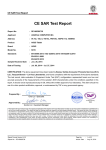
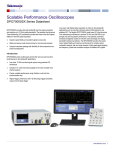

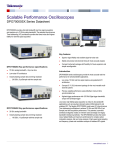
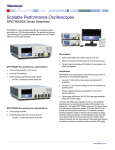
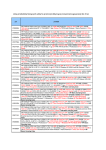
![to a copy of the presentation! [ PDF 3659 kB ]](http://vs1.manualzilla.com/store/data/005993145_1-0ef1bf04b92f9350e985abe9a695cb4d-150x150.png)


